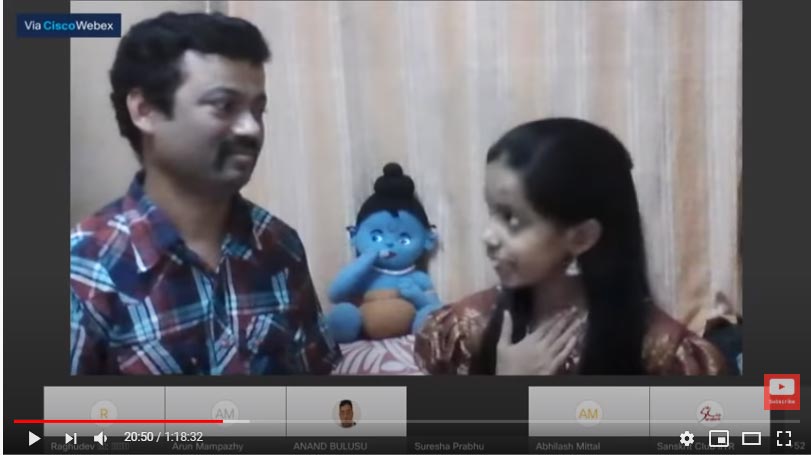Sanskrit learning has attracted people from around the world in recent times. Historically Sanskrit used to be taught through the traditional ‘gurukula sampradaya’ where Sanskrit itself was the medium of teaching as well as for communication among the students.
In the ‘modern’ education system it was replaced by the technique of learning by translation, with emphasis on grammar from the very beginning. It resulted in creating a notion that Sanskrit is merely a language of mantras and traditions as opposed to one of daily conversational usage
During the 1980’s a few young Sanskrit graduates from Rashtriya Sanskrit Vidyapeetha, Tirupati (now National Sanskrit University) felt that efforts must be taken to make Sanskrit once more a spoken language and not merely a language of mantras. “Talk in Samskritam, not just about Samskritam” was their guiding principle.
The primary idea was that Sanskrit should be taught through Sanskrit itself and not through translations. With the united effort of these youngsters, a 10 day Sanskrit workshop was designed where each day, 2 hour sessions are conducted without translations. The method followed was the natural way of learning- just like one learns his or her mother tongue.
Initial days saw a bit of struggle to find takers, and then innovative ways of spreading the effort came up. Two volunteers would ride on a public bus. One would go to the back seat and other in the front seat, and both of them would start talking loudly in fluent Sanskrit. Curious passengers who were able to understand most of the conversation, would ask the volunteers about how they learned to speak in Sanskrit and they will be invited to the next workshop.
The movement slowly started to spread under the aegis of various organisations across India. Eventually Samskrita Bharati was formally established in 1994. Currently, Samskrita Bharati has its headquarters in New Delhi and has a presence in 4812 locations, 610 districts of India and in 20 other countries. Volunteers come from various backgrounds including students, professionals, agriculturists, traders, doctors, lawyers, teachers, engineers, University vice-chancellors and more.
The whole work is anchored by about 114 full-time volunteers dedicated to the cause of spreading Sanskrit as a language of daily use. SamskritaBharati has conducted 1,40,000 sambhashana shibirams(10 day workshops), published over 300 books, conducted correspondence courses, online classes , ‘samvaadasaalaa’ , baalakendram for small children, classes on Bhagavad Gita, youth workshops, teachers training camp and so on.
In the Covid-19 pandemic situation and subsequent lockdown, the organisation took some time to adapt to the digital, online class mode, but eventually got into the groove. Various online workshops and follow up classes are now ongoing around the globe.
What may be an epitome of its online efforts to date, is a course named “Subhashitam Samskritam” which Samskrita Bharati is conducting in association with IIT Roorkee (IITR) Sanskrit club. 14000+ registered, of which nearly 1350 are below 18yrs or age, and nearly 8400 from the 18-40 age group. Many even “complained” that they got to know about the event only after the July-4th registration deadline, had they known in time, they would have registered
The first level of the course started on 5th of July with daily one hour sessions (named as lectures) live streamed on youtube for 12 days. It was supported by daily exercises, audio quizzes, revision videos and interactive sessions – all online. Course-1 focused on basic conversations with no ‘rigour’ of grammar and encourages people to speak in Sanskrit without worrying about “errors”
To the credit of a handful of young and dynamic Sanskrit club volunteers at IIT Roorkee and with key support from the institute, the online classes and supplementary material are public and nicely arranged as playlists in youtube . Though only registrants can take exams, organisers hope that the teaching material can continue to be available as open to all, to the extent possible. That seems to have worked wonders, for lecture-1 of Course-1 has already crossed 40,000 views on youtube

Being free and online classes, not necessarily everyone from the 14000+ registered may be regular, and so based on online exams conducted on July 21 and 22, around 5108 who successfully completed Course-1 and are now registered for Course-2 . Organisers are now exploring ways to give more practice to the enthusiastic members through channels like Telegram discussion group, which already has more than 4000 members.
An online poll conducted among the Telegram members showed that nearly 42% of them learned Sanskrit for the first time using the IITR-Samskrita Bharati Course-1 and most of them were now able to speak in Sanskrit. Even among the 58% who had learned Sanskrit before, most were previously not able able to speak in Sanskrit but after Course-1 they are able to
The Shraavana Pournami day (also rakshabandhan) is celebrated as ‘Samskritadinam’ and this year it falls on 3rd of August. As IITR Sanskrit club-Samskrita Bharati efforts move on to its Course-2, there is immense satisfaction that they were able to pull through a well managed and hugely popular Course-1, and there are also some “lessons learned” and “new ideas” for future implementation. At higher levels of the course, sustaining the interest as well as ensuring that emphasis on conversing in Sanskrit continues, will be challenges to look for.
If the enthusiasm shown for this course is to be taken as a trend, Sanskrit learning may now be at the threshold of undergoing a revolution. The widespread use of internet facilities in the field of education proves to be an opportunity for dissemination of knowledge regardless of geographical boundaries. Time alone can say whether the opportunity will be well used.
The post Sanskrit Teaching’s New Tryst With Destiny appeared first on N4M (News4masses).
from https://news4masses.com/sanskrit-teachings-tryst-with-destiny/
from
https://n4mnetwork0.tumblr.com/post/625072299316527104
No comments:
Post a Comment